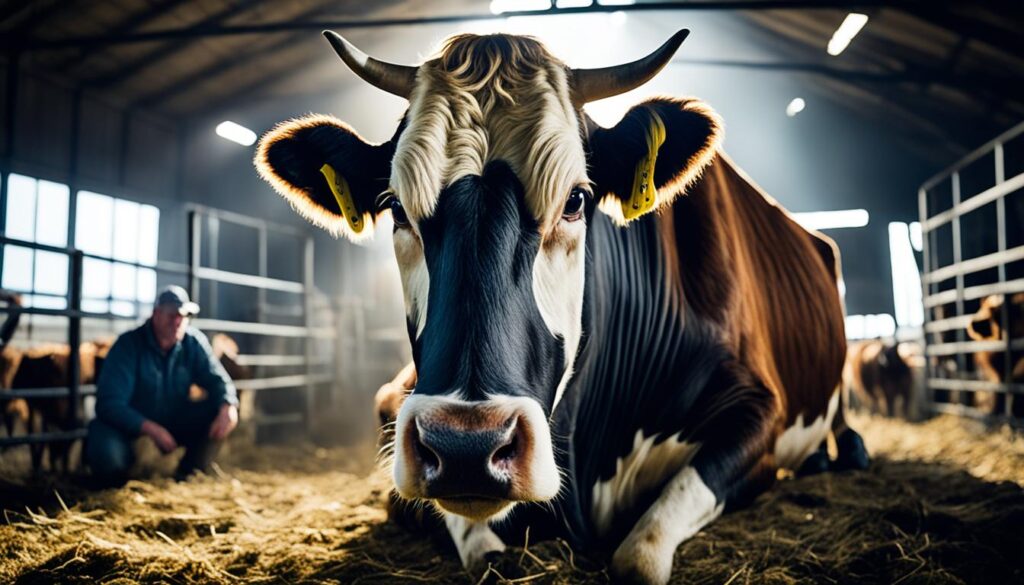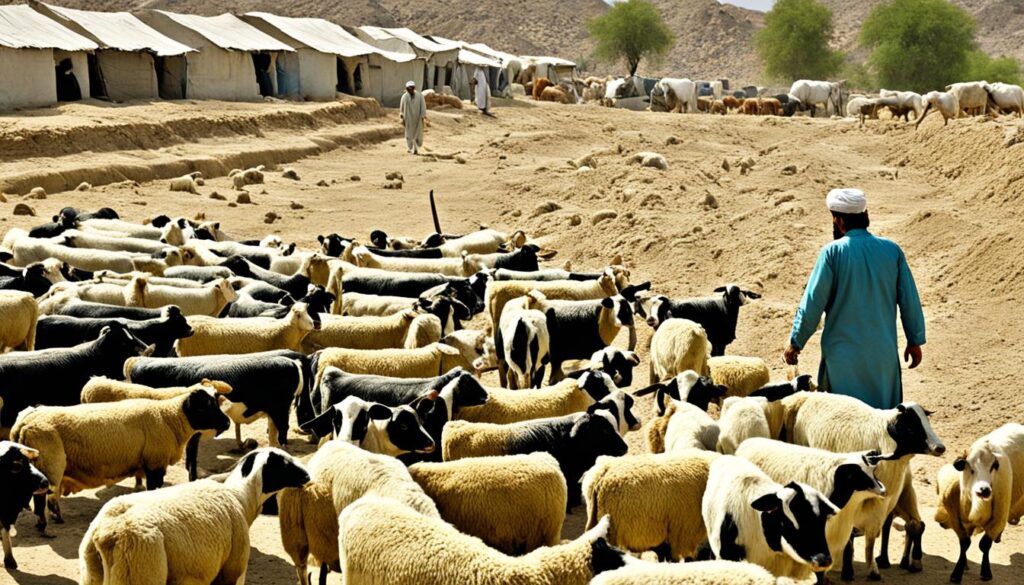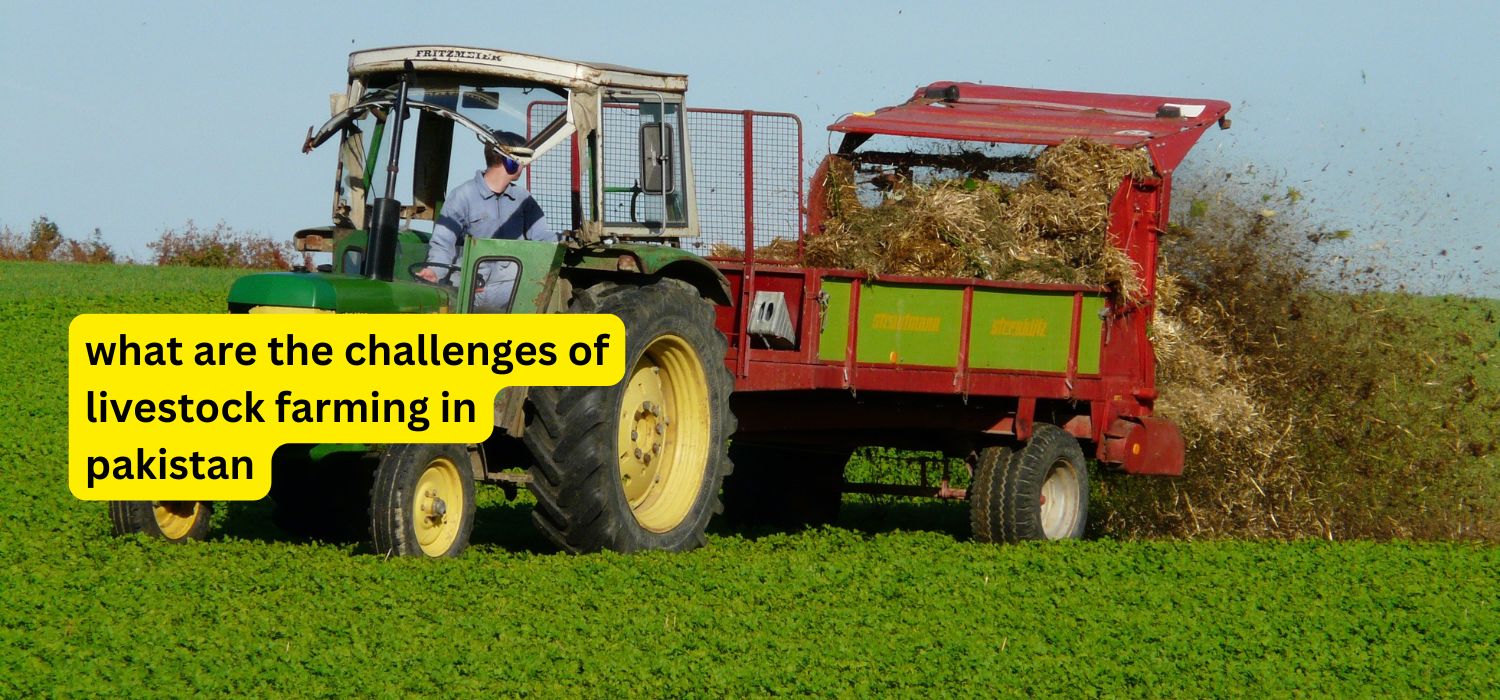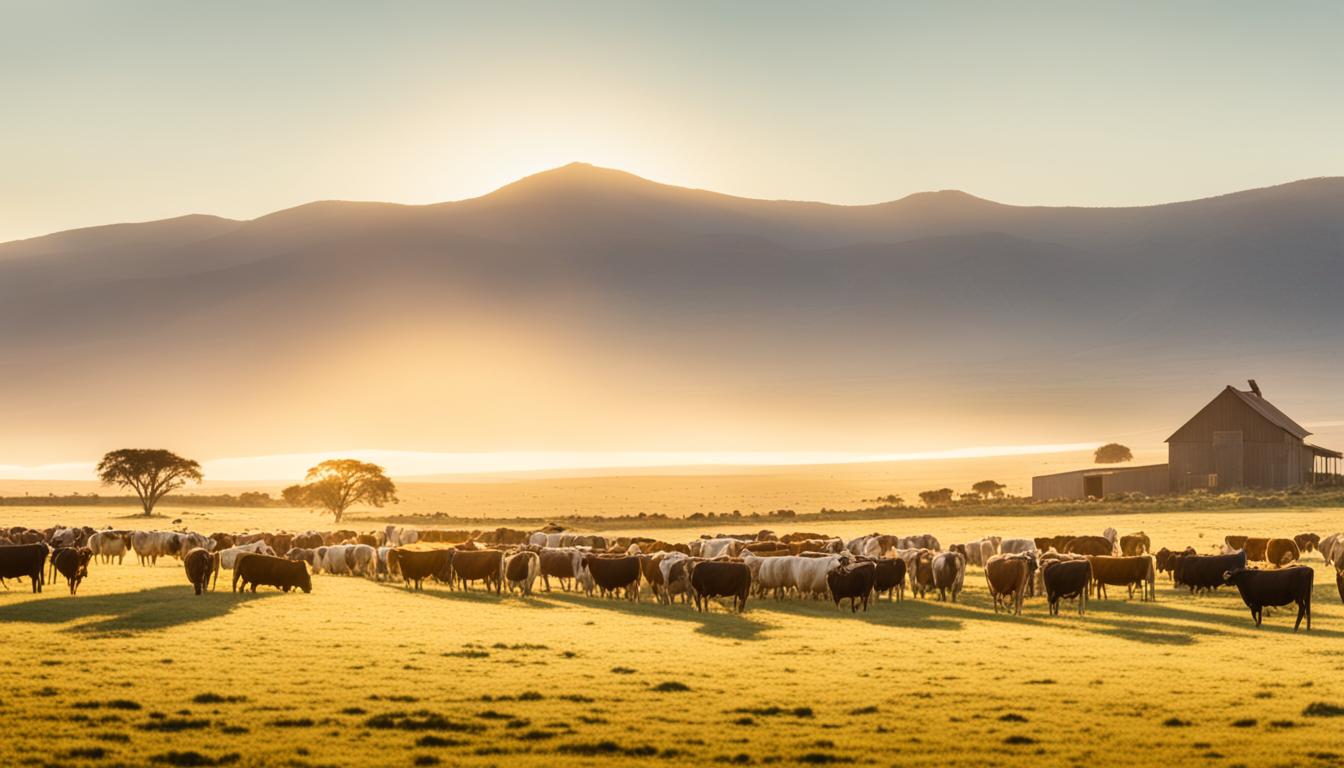As a livestock farmer in Pakistan, you face many challenges. These include feed and fodder shortages, water issues, and animal diseases. These problems can feel huge. But, by understanding them and finding solutions, you can overcome these hurdles and succeed in livestock farming.
This article looks at the main challenges farmers face. It covers animal care, cattle breeding, dairy, and poultry farming. We’ll also talk about environmental and infrastructure problems that affect the industry.
By tackling these challenges, you can make your farm successful for the long run. This will help Pakistan’s agriculture grow and become more sustainable. Let’s look at these challenges in more detail.
Introduction to Livestock Farming in Pakistan
Pakistan’s livestock industry is booming, playing a big role in the economy. It raises a wide variety of animals like cattle, buffalo, sheep, and goats. This shows the country’s deep farming roots.
Overview of the Livestock Industry
The livestock sector is a big part of Pakistan’s farming, making up over 60% of farm output. It covers breeding, raising, and managing different animals like dairy cows, meat animals, and poultry. The country’s varied climate and large grazing lands are perfect for this industry.
Importance of Livestock in Pakistan’s Economy
Livestock farming is crucial for millions of Pakistanis, not just for work but also for the economy. It offers jobs, income, and helps ensure food security by producing meat, milk, and dairy products. Plus, it’s a big earner for Pakistan through exports of animal products to the world.
| Livestock Category | Population (in millions) |
|---|---|
| Cattle | 46.1 |
| Buffalo | 38.3 |
| Sheep | 29.1 |
| Goats | 72.2 |
| Poultry | 1,133.8 |
“The livestock industry in Pakistan is not just a source of livelihood, but a vital component of the nation’s economic and social fabric.”
Feed and Fodder Scarcity
In Pakistan, livestock farmers face a big challenge with feed and fodder scarcity. This problem comes from limited land, tough climate, and not enough feed production. These issues hurt the health and productivity of livestock.
The shortage of feed and fodder in Pakistan is a big worry. It directly hits the health and work of the country’s big livestock. Farmers find it hard to give their animals the right nutrients. This leads to slower growth, less milk and meat, and more sickness.
Causes of Feed and Fodder Scarcity
- Limited Arable Land: Pakistan has many small farms, leaving little space for growing feed and fodder crops.
- Climatic Challenges: The country’s weather is hard to predict, with long droughts and unpredictable rains. This makes it tough to get a steady supply of feed and fodder.
- Inadequate Feed Production: Pakistan doesn’t make enough feed and fodder to meet the livestock’s needs. This creates a big gap between what’s made and what’s needed.
| Livestock Feed Shortage in Pakistan | Estimated Deficit |
|---|---|
| Dry Fodder | 22 million tons |
| Green Fodder | 35 million tons |
| Concentrates | 3 million tons |
Fixing the feed and fodder shortage in Pakistan is a big task. It needs a detailed plan to solve. It’s key for the livestock sector’s growth and for the country’s economy and food safety.
“The scarcity of feed and fodder is a major obstacle for livestock farmers in Pakistan, hampering their ability to maintain the health and productivity of their animals.”
Water Shortage for Livestock
Livestock farmers in Pakistan face a big challenge: not enough water. They rely a lot on water, and drought and poor water use make things worse.
Impacts of Drought on Water Availability
Drought hits hard on livestock water supply in Pakistan. Animals can’t get enough water, leading to dehydration, less milk, and even death. It also hurts the growth of food crops for the animals.
Inefficient Water Management Practices
On top of drought issues, Pakistan’s livestock sector struggles with poor water use. Old irrigation systems, bad water storage, and not knowing how to save water add to the problem. This is a big deal, as better water use could lessen drought effects and keep animals hydrated.
Fixing the water shortage for livestock is key for Pakistan’s farming future. By using new water strategies, promoting tough animals, and improving water systems, farmers can protect their animals and keep farming going.
“Sustainable water management is the key to ensuring the resilience of Pakistan’s livestock industry in the face of climate change and drought.”
Animal Disease Outbreaks
Livestock farmers in Pakistan face a big challenge with animal diseases. These diseases hurt the health and work of animals and threaten the success of the livestock industry. Knowing about common diseases in Pakistan helps farmers prevent and manage them.
Common Livestock Diseases in Pakistan
Some top diseases in Pakistan’s livestock include:
- Foot-and-Mouth Disease (FMD): A highly contagious viral disease that affects animals like cattle, buffaloes, sheep, and goats. It causes fever, blisters, and lameness.
- Hemorrhagic Septicemia (HS): A bacterial disease mainly in cattle and buffaloes. It leads to high fever, nasal discharge, and severe bleeding inside.
- Peste des Petits Ruminants (PPR): A viral disease affecting small animals like sheep and goats. It causes fever, mouth sores, and breathing problems.
- Brucellosis: A bacterial disease hitting cattle, buffaloes, and small animals. It causes reproductive issues like abortions and infertility.
- Lumpy Skin Disease (LSD): A viral disease in cattle, bringing fever, skin bumps, and less milk.
| Disease | Affected Livestock | Symptoms |
|---|---|---|
| Foot-and-Mouth Disease (FMD) | Cattle, buffaloes, sheep, goats | Fever, blisters, lameness |
| Hemorrhagic Septicemia (HS) | Cattle, buffaloes | High fever, nasal discharge, internal bleeding |
| Peste des Petits Ruminants (PPR) | Sheep, goats | Fever, oral lesions, respiratory distress |
| Brucellosis | Cattle, buffaloes, small ruminants | Reproductive problems, abortions, infertility |
| Lumpy Skin Disease (LSD) | Cattle | Fever, skin nodules, reduced milk production |
Good strategies like vaccines, keeping animals safe, and better vet care are key to fighting animal disease outbreaks. They help protect against common livestock diseases in pakistan.

“Controlling animal diseases is essential for the sustainability and profitability of the livestock industry in Pakistan.”
Lack of Veterinary Services and Infrastructure
The livestock industry in Pakistan faces big challenges, like disease outbreaks and a lack of veterinary services. This makes it hard for animals to get the healthcare they need. It also hurts the productivity and profits of farming.
There’s a big problem with veterinary facilities in the country. Many places in rural areas don’t have even basic clinics. Farmers have to travel far to get help for their animals. This is expensive and often stops them from getting the care their animals need.
Pakistan also doesn’t have enough trained vets. The system doesn’t make enough qualified vets to meet the demand. This means farmers often can’t find the help they need to take care of their animals properly.
This shortage of vets and facilities has big effects on farming. Without good healthcare, animals get sick more often. This means less milk and meat, fewer babies, and more animals die. This hurts the farmers’ income and the whole farming industry.
To help the livestock sector, we need to fix the lack of vets and facilities. The government and industry should invest in better vet clinics and training more vets. This will make animals healthier and help the farming industry do better.
what are the challenges of livestock farming in pakistan
Livestock farming in Pakistan has many challenges that affect its growth and sustainability. These include feed and water scarcity, animal diseases, and lack of infrastructure. These issues make it hard for the country to fully use its livestock potential. It’s important to understand these challenges to find solutions and make farming sustainable.
The main issue is the scarcity of feed and fodder. Livestock depend on natural grazing and crop residues, but these are getting less due to drought, overgrazing, and land competition. This shortage hurts animal health, productivity, and makes farming more expensive.
Another big problem is the water shortage. Drought and poor water management limit access to water, which is key for livestock. Climate change makes this worse, adding to the challenges of farming in Pakistan.
- Outbreaks of animal diseases are a big threat to livestock health and productivity. Diseases like foot-and-mouth and Newcastle disease can kill many animals and cost farmers a lot of money.
- The lack of veterinary services and infrastructure is also a big challenge. Many rural areas don’t have good vet care, making animals more likely to get sick and hurting farming efficiency.
| Challenge | Impact |
|---|---|
| Feed and Fodder Scarcity | Reduced livestock health, productivity, and increased production costs |
| Water Shortage | Decreased water availability for livestock, exacerbated by climate change |
| Animal Disease Outbreaks | High mortality rates, economic losses, and reduced livestock productivity |
| Lack of Veterinary Services | Inadequate disease prevention, management, and overall livestock health care |
To solve these challenges, we need a plan that includes government policies, infrastructure investment, and new farming methods. By improving feed, water, animal health, and vet services, Pakistan can make its livestock sector more sustainable and productive.
“Sustainable livestock farming is not just about enhancing production, but also about ensuring the well-being of animals and the long-term viability of the industry.”

Cattle Rearing Difficulties
Raising cattle is a big challenge for farmers in Pakistan. They face issues with improving breeds, housing, and managing their cattle. These problems make it hard for the cattle farming sector to grow.
Breed Improvement Challenges for Livestock in Pakistan
Improving cattle breeds is key in Pakistan. Many farmers can’t get their hands on quality breeding stock. This limits how much they can improve their cattle’s genetics. It also affects their cattle’s productivity and overall growth in the livestock industry.
Livestock Housing and Management Issues in Pakistan
Good housing and management are vital for cattle’s health and productivity. But, many farmers in Pakistan struggle to give their animals proper living conditions. They lack suitable shelters, clean water, and good feeding and healthcare. This leads to lower productivity and more diseases.
| Cattle Rearing Challenges in Pakistan | Impacts |
|---|---|
| Breed Improvement Challenges | Reduced productivity and performance of cattle herds |
| Livestock Housing and Management Issues | Decreased animal welfare, increased disease risk, and lower productivity |
“Addressing the challenges in cattle rearing is crucial for the sustainable growth of the livestock industry in Pakistan.”
Dairy Farming Obstacles
Dairy farming is crucial to Pakistan’s livestock industry but faces many challenges. These challenges affect its growth and productivity. Farmers deal with limited access to quality feed, low milk yields, and marketing issues.
One big problem is finding enough nutritious feed and fodder. High prices and a lack of essential ingredients make it hard for farmers to feed their cows well. This hurts milk production. Climate change also makes things worse by changing where cows can graze and reducing natural resources.
Another big issue is that dairy cows in Pakistan don’t produce as much milk as they should. This means the dairy sector can’t be as productive or profitable as it could be. Poor breeding, bad management, and lack of good vet care and tech are some reasons.
Marketing and getting products to market are also tough for dairy farmers. They often can’t find good prices for their milk and dairy products. They depend on middlemen who pay low prices. There’s also no good cold chain or transport systems, making it hard to sell to more people.
To fix these problems, we need a big plan. This plan should include government help, new technology, and training for farmers. By tackling these issues, dairy farming in Pakistan can grow and help the country’s food security and economy.
Poultry Farming Hurdles
Poultry farming in Pakistan has its own set of challenges. These challenges affect its productivity and profits. Managing poultry diseases and ensuring quality feed are big hurdles.
Poultry Disease Management
Poultry farmers in Pakistan face big challenges with poultry diseases. Diseases like Newcastle disease, infectious bronchitis, and avian influenza can wipe out flocks. This leads to huge economic losses.
It’s important to have good biosecurity, vaccination, and quick vet care. These steps help keep poultry healthy and reduce disease impact.
Feed Quality and Availability
Getting quality poultry feed is hard for the industry. The cost and availability of feed ingredients like corn and soybean change often. This can mess up poultry farms.
Bad feed quality hurts the growth and performance of the birds. To fix this, farms need to focus on getting good feed, processing it well, and checking its quality.
| Poultry Farming Hurdles in Pakistan | Impact |
|---|---|
| Poultry Disease Management | Outbreaks of diseases like Newcastle disease, infectious bronchitis, and avian influenza can lead to significant economic losses for poultry farmers. |
| Feed Quality and Availability | Fluctuations in the availability and cost of feed ingredients, as well as substandard feed quality, can disrupt the operations and productivity of poultry farms. |
To beat these challenges, poultry farmers in Pakistan should focus on preventing diseases. They should invest in keeping farms safe and work on better feed supplies. By doing this, the industry can grow stronger and help Pakistan’s agriculture and economy.
Meat Production Hurdles
Pakistan’s livestock industry faces big challenges in meat production, just like dairy and poultry farming. Livestock farmers struggle with many issues, including finding enough food and controlling diseases. They also face problems in selling their products.
Feed Scarcity and Quality Concerns
One big issue for meat producers in Pakistan is finding enough good animal feed. Not having enough or good quality feed can slow down animal growth and lower meat production. Farmers often find it hard to get affordable, nutritious food for their animals.
Disease Outbreak Risks
Diseases in livestock can really hurt meat production in Pakistan. Diseases like foot-and-mouth disease and Lumpy Skin Disease can spread fast, hurting animal health and meat production. It’s important to have good disease control to keep the meat production going.
Marketing and Distribution Challenges
Meat producers in Pakistan have trouble finding good ways to sell their products. They often lack good storage and transport options. This makes it hard to get meat to consumers on time. They also struggle to connect with buyers, which can lower their profits and slow business growth.
| Challenge | Impact on Meat Production | Potential Solutions |
|---|---|---|
| Feed Scarcity and Quality Concerns | Reduced livestock growth and productivity, leading to lower meat yields | Improving access to high-quality and affordable animal feed through government initiatives and private sector collaborations |
| Disease Outbreak Risks | Significant losses in animal health and productivity, disrupting meat supply | Strengthening disease surveillance, prevention, and control measures through enhanced veterinary services and infrastructure |
| Marketing and Distribution Challenges | Difficulty in reaching consumers, limiting market access and profitability | Investing in cold storage facilities, transportation networks, and developing efficient supply chain management |
Fixing these meat production problems in Pakistan is key for the industry’s future. It will help ensure a steady supply of quality meat for the growing population.
Animal Husbandry Issues
In Pakistan, many farmers use old ways of raising livestock. These methods make it hard for the animal husbandry industry to grow. They limit how much the industry can do.
Traditional Farming Practices
One big problem is the use of old farming methods. Many farmers stick with old techniques instead of new, better ones. They don’t use much technology, like automated feeders or advanced breeding methods. They also don’t have good places for animals to live and are not managing them well.
Also, traditional livestock farming practices in Pakistan often don’t focus on keeping animals healthy. Animals don’t get the care they need to stay healthy. This makes them more likely to get sick, which hurts their work and well-being. It also causes big money problems for farmers and the whole industry.
| Traditional Farming Practices | Modern Farming Practices |
|---|---|
| Limited use of technology | Automated feeding systems, advanced breeding techniques |
| Lack of proper animal housing and management | Improved animal housing and management strategies |
| Limited veterinary care and disease prevention | Comprehensive veterinary services and disease prevention measures |
To fix these problems and help the animal husbandry industry in Pakistan, farmers need to try new ways. They should invest in technology, better living places for animals, and more health care. This will make farming more productive, profitable, and sustainable.

Livestock Breeding Problems
In Pakistan, breeding livestock well is key to keeping herds healthy and productive. But, farmers face big challenges. A big issue is not having enough artificial insemination services. These services are key to better genetics and breeding in livestock.
Lack of Artificial Insemination Services
Many farmers in Pakistan don’t have access to artificial insemination. This leads to big problems, like:
- Reduced genetic diversity: Without artificial insemination, farmers stick to natural mating. This limits the gene pool and lowers genetic diversity.
- Lower reproductive rates: Not having artificial insemination means lower conception rates and more reproductive issues, like infertility.
- Slower genetic progress: Without artificial insemination, improving the genetics of livestock is harder. This slows down breed improvement and productivity.
This makes breeding livestock in Pakistan less productive and less profitable. It shows we need more investment in artificial insemination services across the country.
| Challenge | Impact |
|---|---|
| Lack of Artificial Insemination Services |
|
Environmental Challenges
Pakistan’s livestock farming faces big environmental challenges that affect its growth and sustainability. These challenges include the effects of climate change and the ongoing issues of overgrazing and land degradation.
Climate Change Impacts
The livestock sector in Pakistan is very sensitive to climate change effects. Rising temperatures and unpredictable rainfall have made it hard to find food and water for animals. This has led to lower productivity, more animal deaths, and more diseases.
Extreme weather events like heatwaves and floods have also caused problems. They damage farms and disrupt the supply chain. These issues make it tough for farmers to keep their animals healthy.
Overgrazing and Land Degradation
Overgrazing is a big problem in Pakistan, where more animals are being raised. Too many animals eating the same land has destroyed plants and made the soil poor. This has caused the land to become less fertile and has led to desertification.
Loss of land and poor habitats have made things even harder for farmers. It’s important to balance the number of animals with the land’s ability to support them. This is key to making the livestock farming sustainable in the long run.
| Environmental Challenge | Impact on Livestock Farming |
|---|---|
| Climate Change |
|
| Overgrazing and Land Degradation |
|
“Addressing the environmental challenges facing livestock farming in Pakistan is crucial for the long-term sustainability and resilience of the sector.”
Marketing and Transportation Challenges
Livestock farmers in Pakistan face big challenges in marketing and transporting their products. These issues make it hard to move and sell livestock and their products efficiently. They are mainly due to poor logistics and infrastructure.
One big problem is the lack of good marketing channels and networks. Many farmers find it hard to find buyers, which means they can’t get fair prices for their animals and products. This is worse for small-scale producers who don’t have the resources or power to negotiate well.
| Challenge | Impact |
|---|---|
| Underdeveloped marketing infrastructure | Difficulty in reaching customers, limited bargaining power, and reduced profitability for livestock farmers |
| Inadequate transportation network | Increased costs, delays, and quality deterioration of livestock and livestock products during transit |
| Limited access to cold storage facilities | Reduced shelf life and quality of perishable livestock products, leading to financial losses for farmers |
Transportation in many parts of Pakistan is also a big problem. It makes it hard for farmers to get their products to markets and processing places. Bad roads, unreliable transport, and not enough refrigerated vehicles cause extra costs, delays, and harm the quality of the products.
To fix these issues, farmers need a detailed plan. This should include investing in better infrastructure, creating organized marketing channels, and offering logistical help and training. By doing this, Pakistan’s livestock sector can grow and benefit both farmers and consumers.
Conclusion
This article looked at the tough challenges faced by livestock farmers in Pakistan. They deal with a lot, from not having enough food and water to fighting diseases and poor infrastructure. Understanding these what are the challenges of livestock farming in pakistan helps find ways to make farming better.
The main issues include not having enough food and water, diseases in animals, and poor veterinary care. There are also problems with raising cattle, dairy farming, and producing meat. Other challenges include breeding animals, dealing with the environment, and getting products to market. Fixing these problems is key to making Pakistan’s livestock industry stronger.
The livestock sector is very important to Pakistan’s economy. To overcome these challenges, we need to make smart plans, work together, and invest wisely. This way, the industry can grow and help Pakistan’s agriculture and economy a lot.


